All published articles of this journal are available on ScienceDirect.
Assessment of Small Diameter Steel Pile as a Stabilizing Element for Transmission Tower Slope Stability
Abstract
Background:
Stabilization of unstable slopes with relatively large reinforced concrete piles has been widely adopted over the past several decades. Small diameter steel piles have several advantages as a slope reinforcement technique for an unstable transmission tower slope where space and access restrictions that typically occur render alternate approaches unfeasible.
Methods:
In this study, a numerical performance assessment of small diameter steel pile as a stabilizing element for transmission tower slope stability was carried out using an uncoupled analysis, in which the pile response and slope stability are considered separately. Numerical evaluations are presented and the influencing parameters that could affect the behavior of reinforcing piles to increase transmission tower slope stability are investigated.
Results:
The numerical analysis results indicate that the soil properties, slope geometry, pile location, pile diameter, pile length and number of pile rows have a combined effect on the performance of small diameter steel piles to stabilize transmission tower slopes.
Conclusion:
The numerical assessment can satisfactorily capture some fundamental response of transmission tower slope reinforced with multi-row small diameter steel piles.
1. INTRODUCTION
The stabilization of slopes using a row of a large diameter piles has been widely adopted in past decades [1-13]. Review of available literature shows that there are several empirical and numerical methods for designing slope stabilizing piles. They can generally be categorized into (1) analytical methods [1-9] and (2) numerical methods [10-13]. The analytical methods (pressure/displacement-based methods) are uncoupled solutions in which the slope stability and pile response are considered separately. The numerical methods (finite element /finite difference methods) provide coupled solutions in which slope stability and pile response are considered simultaneously. The numerical methods are in principle the most rigorous but they are computationally intensive and time-consuming. The use of small diameter steel piles has been employed to stabilize slopes or to improve slope stability [14-17].
The lateral force acting on stabilizing piles due to the soil movement of the landslide has been studied by many researchers [1, 18-23]. The limit equilibrium solution of a pile force acting on a row of stabilizing piles proposed by Ito and Matsui [1] has been widely adopted by researchers to develop a general method of stability analysis for a slope reinforced by piles [1, 18-20]. Keawsawasvong and Ukritchon [22] proposed a closed-form equation of the limiting pressure factor for a convenient and accurate prediction of the lateral force acting on a pile in contiguous pile walls in practice. Keawsawasvong et al. [23] established plasticity solutions for determining the limiting uniform normal pressure acting horizontally behind cohesive-frictional backfill material in a deep contiguous piled wall.
The lateral loaded pile capacity is an important design parameter for pile foundation designed to resist lateral force induced from slope movements. Several studies on laterally loaded pile response have been carried out in the past to understand and determine the lateral loaded pile capacity [24-26].
Small diameter steel piles have several advantages as a slope reinforcement technique for an unstable transmission tower slope where space and access restrictions that typically occur render alternate approaches unfeasible. The small diameter steel piles can be installed quickly and provide immediate strength improvements to avoid transmission tower failure and disrupting power supply. However, the use of multi-row small diameter steel piles to stabilize transmission tower slopes or to improve slope stability has rarely been studied.
In this paper, the parametric analysis has been performed to study the effect of the multi-row small diameter steel piles on the stability of the transmission tower slope using an uncoupled analysis, in which the pile response and slope stability are considered separately. Numerical evaluations are presented and the influencing parameters that could affect the behavior of reinforcing piles to increase transmission tower slope stability are investigated.
2. MATERIALS AND METHODS
2.1. Analysis Method
GEO5 Slope Stability Analysis [27] commercial program based on Mohr-Coulomb soil strength criterion is used to determine the transmission tower slope-pile stability, critical slip surface location and the active and passive forces acting on the stabilizing pile wall. Then these computed active and passive forces and slip surface location are transferred to GEO5 AntiSlide Pile commercial program [28] based on pile foundation on Winkler soil model to compute the distributions of the internal forces, bending moment and displacement of the stabilizing piles.
Moamen [29] employed the similar GEO5 software to investigate the performance of 200 reinforced concrete piles with 0.6 m diameter, 10 m long and 2.4 m spacing used to stabilize an 8-m high railway embankment of Weald Clay at Hildenborough, Kent, UK. The computed results show that using the anti-slide piles is an effective method to increase the factor of safety for the slopes.
2.2. Validation of the Present Method
The validation of the present method was performed by comparing the results with those obtained from other methods.
Hassiotis et al. [18] and Won et al. [19] carried out numerical analyses to study the effect of stabilizing piles on the stability of an idealized slope by using a pressure-based coupled analysis and Bishop’s simplified analysis, respectively. The idealized homogeneous slope has a height of 13.7m with a slope angle of 30˚, unit weight of 19.63 kN/m3, cohesion of 23.94 kN/m2 and friction angle of 10˚. A row of concrete piles with a diameter (d) of 0.62m embedded into a stable layer was used.
Fig. (1) shows that the rate of increase in the safety factor of a slope decreases with increasing the pile spacing (s) computed by the three methods. It also shows that the safety factor computed by present analysis is similar to that by the simplified Bishop analysis (Won et al. [19]) but slightly higher than that by the pressure-based coupled analysis (Hassiotis et al. [18]).
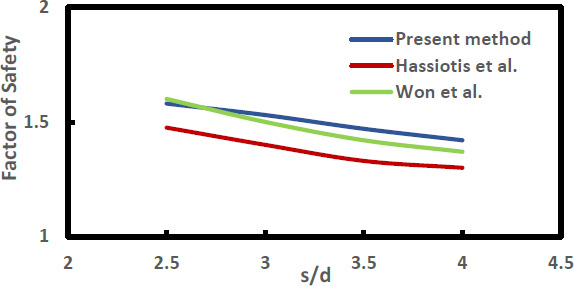
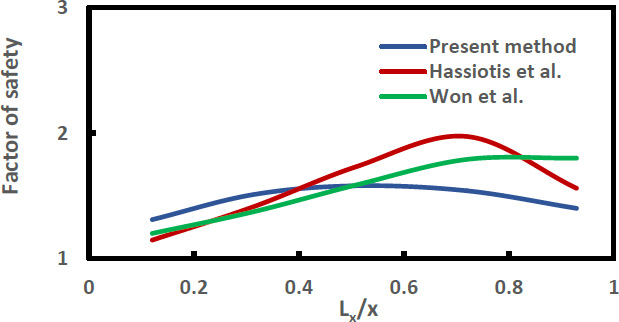
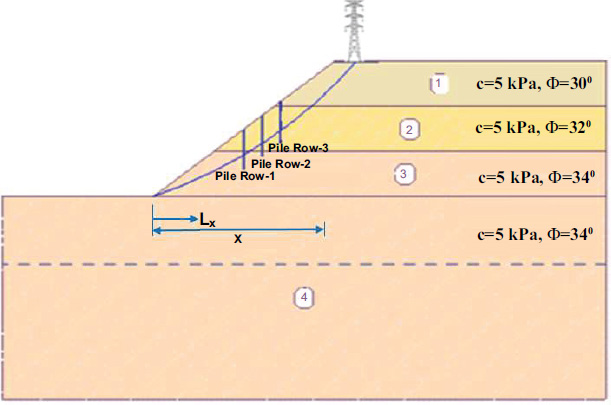
Fig. (2) shows the effect of the pile positions on the safety factor of a slope stabilized with piles (where Lx= pile location from slope toe and x= slope width). The numerical results computed by the present method indicate that the safety factor is largest when the piles are placed near to the middle of the slopes. However, the solutions obtained by using the pressure-based coupled analysis (Hassiotis et al. [18]) and Bishop simplified analysis (Won et al. [19]) indicate that the piles should be placed slightly towards to the crest of the slope for the largest safety factor.
3. RESULTS AND DISCUSSION
3.1. Parametric Analysis
A numerical assessment of the performance of small diameter steel pile as a stabilizing element for transmission tower slope stability was performed using the present uncoupled method. The small diameter steel piles used are steel pipe piles with 90 mm in diameter, 5 mm in thickness, 6 m in length and has a Young’s modulus of 2x1011 kN/m2. The properties of the homogeneous weathered residual soil slope are: cohesion (c) = 5 kN/m2, friction angle (φ) = 35˚, unit weight= 18 kN/m3, slope height= 20 m and slope inclination (β) = 40°. Fig. (3) shows the soil properties used in layered weathered residual soil slope. The water table was not considered here. A 137kV transmission tower with 996 kN axial load was assumed located on the slope crest. The parametric study carried out was based on these soil and pile properties unless otherwise stated.
To assess the effect of small diameter passive piles on the stability conditions of a transmission tower slope, a conceptual slope profile with multi-row piles in parallel arrangement was used as shown in Fig. (3) (where Lx= pile location from slope toe and x= slope width). To focus on the comparison in terms of pile row effect, normalised pile spacing of s/d=3 (where s= pile spacing and d=pile diameter), normalised pile row spacing of sr/x=0.1 (where sr= pile row spacing and x=slope width) for multi-row small diameter steel piles were employed in the parametric study.
3.2. Homogeneous Soil Slopes
Fig. (4) shows the slope stability improvement factor If=Fp/Fs (Fs= factor of safety for unreinforced tower slope and Fp= factor of safety for pile reinforced tower slope) of the transmission tower slope for two-row small diameter steel piles decreases with an increase of pile location (Lx) from the slope toe indicating the piles more effectively reinforce the slope where the stabilizing force can produce maximum stabilzation effect when they are closer to the slope toe. Fig. (4b-4d) show the corresponding maximum pile displacement, shear force and bending moment increase with increasing pile location (Lx). However, for the Pile Row-2, they increase up to the middle of the slope and then decrease thereafter. It is observed that the Pile Row-2 are subjected to more soil pressure resulting higher maximum pile displacement, shear force and bending moment than the Pile Row-1 due to soil arching mechanism.
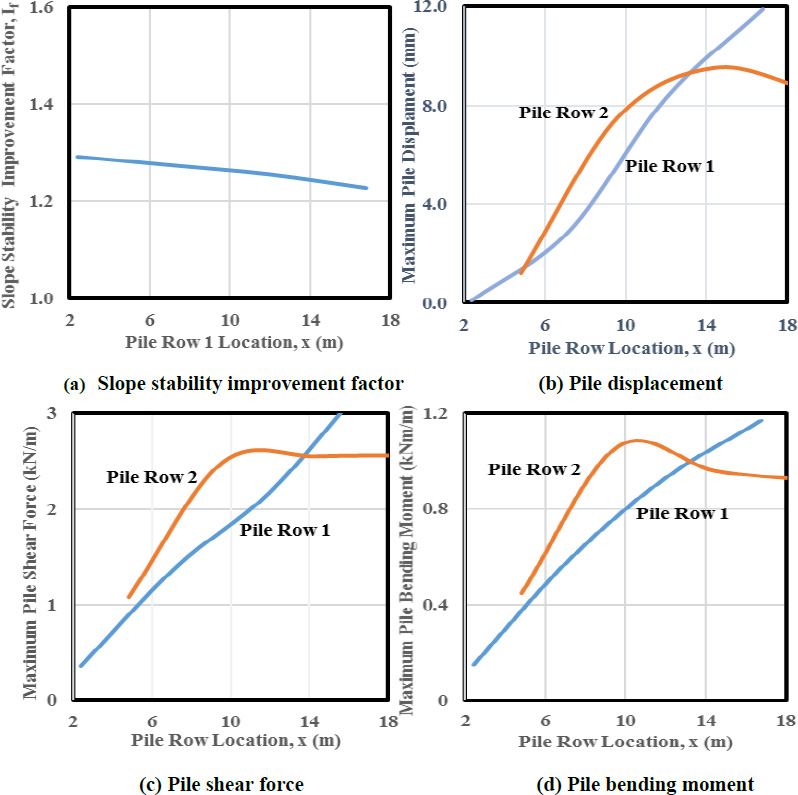
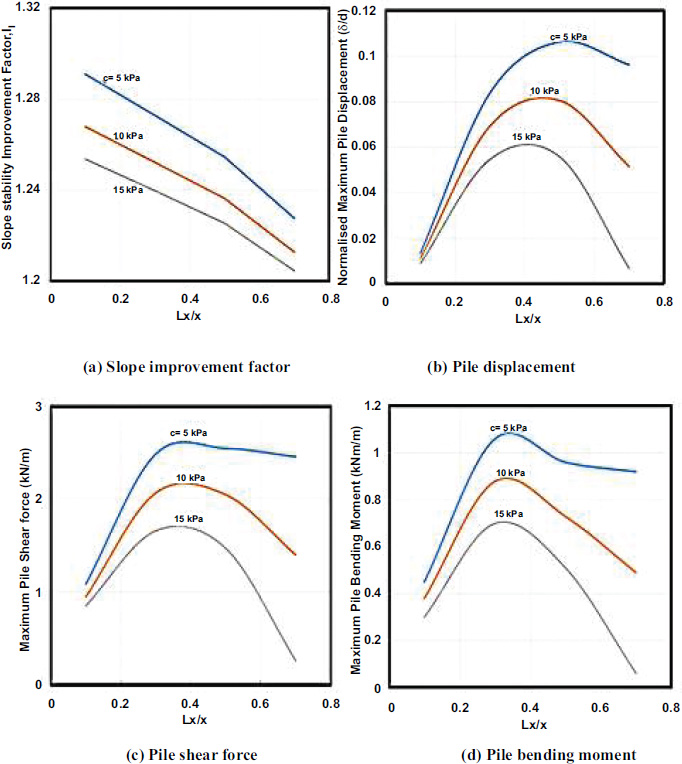
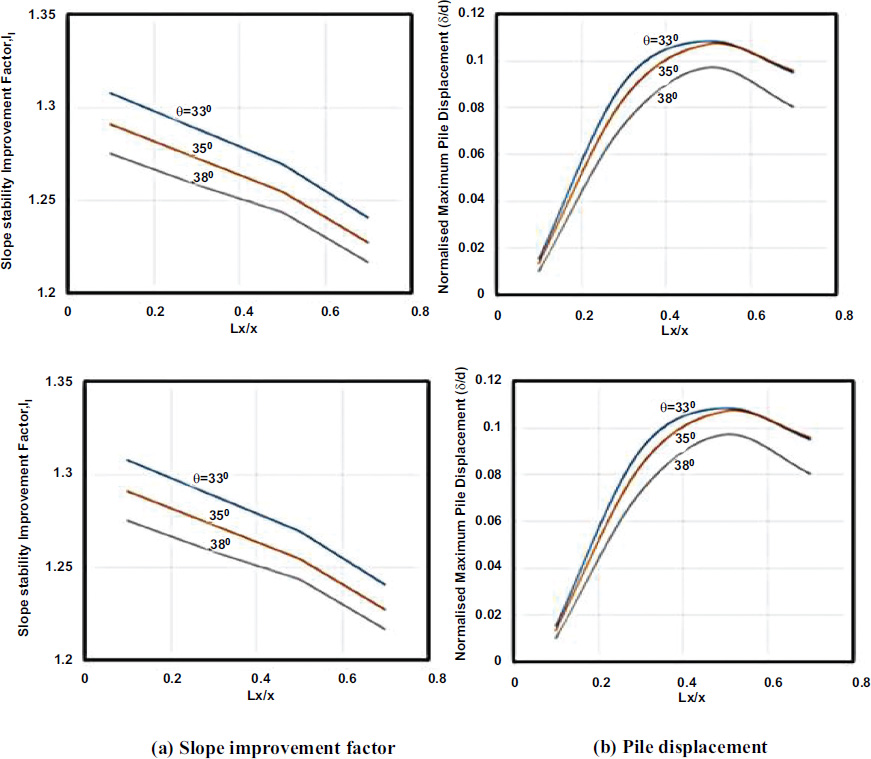
The factor of safey (Fp) for a slope reinforced with two-row small diameter steel piles increases with increasing soil strength parameters (c and ϕ). The rate of increase in Fs appears to be higher than that in Fp resulting smaller slope improvement factor (If=Fp/Fs) with increasing soil strengths parameters as shown in Figs. (5 and 6). The maximum pile displacement, shear force and bending moment decrease with increasing soil strength parameters. However, they increase up to the middle of the slope and then decrease thereafter. The increasing soil strength parameters may change the main mode of the pile movement from translation to rotation.
Fig. (7) shows the slope improvement factor (If) for three-row piles increases with increasing pile diameter (d) with constant pile length (L). The maximum pile displacement decreases with increasing pile diameter due to increase in structural stiffness. It appears that larger diameter pile develops minimum displacement but greater bending moment value. Whereas smaller diameter pile develops maximum displacement but lower bending moment value. The stiffer piles provide larger resistance to movement, and as a result, are more effective in mitigating a failing slope. However, the larger diameter piles are also heavier, harder to drive and more expensive.
The failure mechanism depends on the embedded pile length within the underlying stable soil layer in the slope. The small diameter steel pile length used in this study which is greater than its critical length has little effect on the slope improvement factor (If), maximum pile displacement, shear force and bending moment as shown in Fig. (8). The maximum pile displacement, shear force and bending moment increase with increasing pile location (Lx) from the slope toe. However, they increase up to the middle of the slope and then decrease thereafter.
Fig. (9) shows that the slope improvement factor (If) increases with increasing number of pile rows for various slope inclinations. The multi-row small diameter steel piles have been found to be more resistance to soil movement due to multiple soil arching effects that can provide greater resisting force resulting higher factor of safety of the transmission tower slope. The multi-row small diameter steel piles may be more effective and economical than the single-row small diameter steel piles under large landslide thrust force.
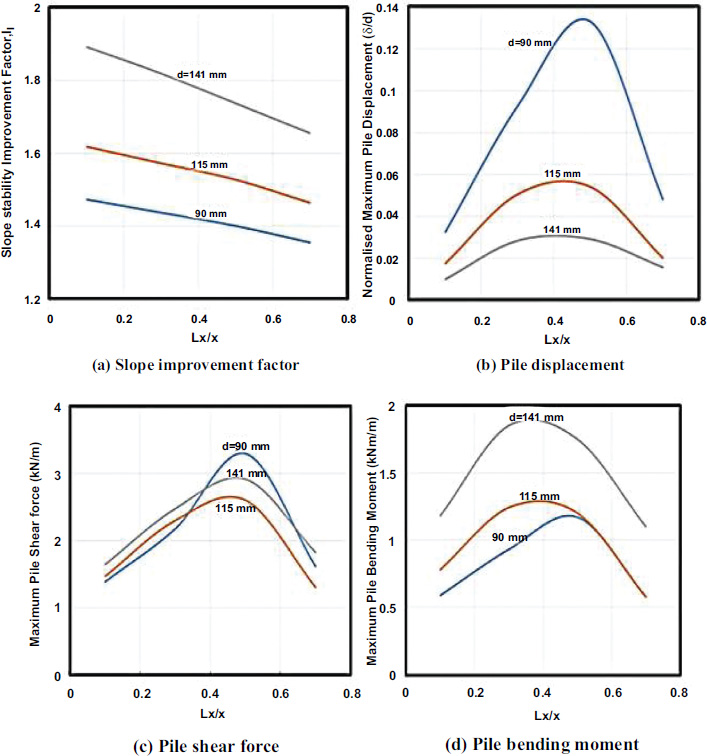
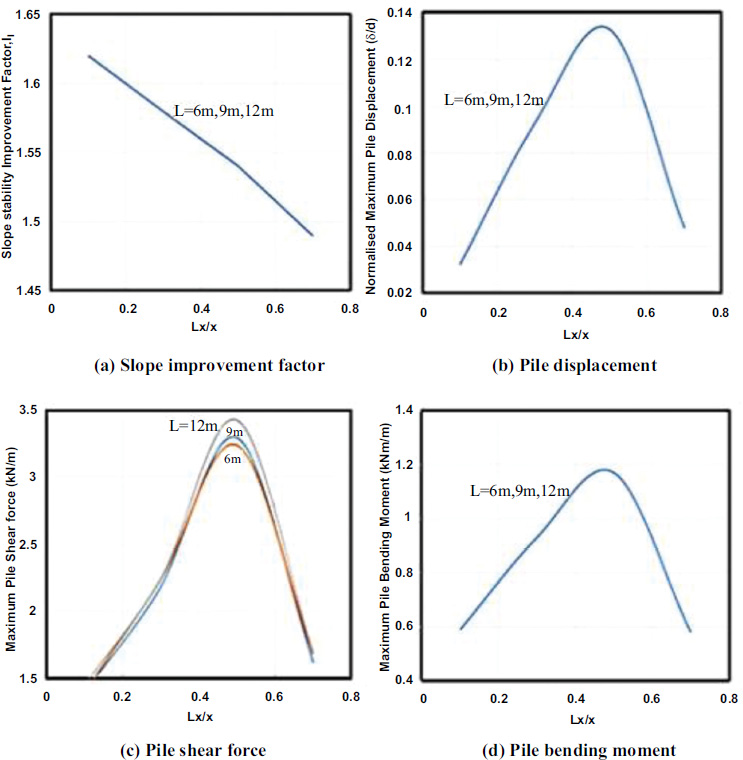
3.3. Layered Soil Slopes
Fig. (10) illustrates the maximum pile displacement, shear force and bending moment increase with increasing pile location (Lx) for three-row small diameter steel piles in layered soil slope as shown in Fig. (1). However, for Pile Row-2 and Row-3, they increase up to the middle of the slope and then decrease thereafter. The depth of the failure surface at the pile location has a considerable effect on the soil-pile interaction and the mode of failure in pile-stabilized slopes. For the row of small diameter steel piles subjected to relatively shallow depths of sliding located close to the slope toe and crest, the dominant mechanism is flow of soil past the piles by rigid-body rotation without substantial flexural distortion and the group effects do not seem to play an important role. However, for the row of small diameter steel piles subjected to larger sliding depths located near the middle of the slope, the resistance developed by pile increases significantly when subjected to large sliding depth increases and the pile behaves as flexible and group effects play an increasingly important role. The Pile Row-2 and Row-3 are subjected to more soil pressure resulting higher maximum pile displacement, shear force and bending moment than the Pile Row-1 due to arching mechanism.
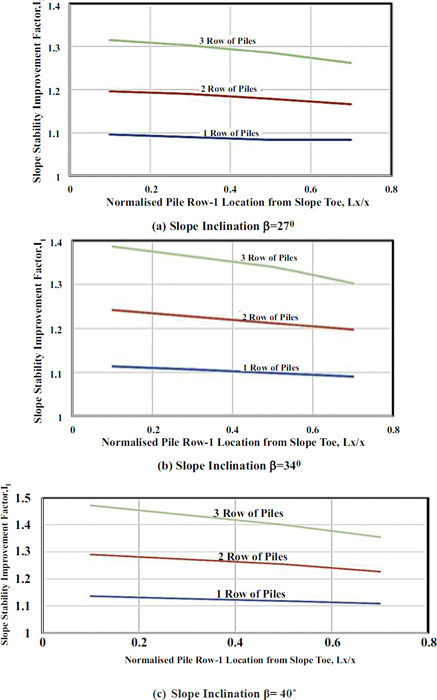

CONCLUSION
In this study, an uncoupled analysis has been employed to assess the factors affecting the response of transmission tower slope reinforced with multi-row small diameter steel piles. The various parameters considered in this study includes soil properties, slope geometry, pile location, pile diameter, pile length and number of pile rows. The results indicate that stabilizing small diameter steel piles can have a significant effect in improving the factor of safety of transmission tower slope. The larger diameter pile gives minimum displacement but larger bending moment value. The stiffer piles provide larger resistance to slope movement and are more effective in mitigating a failing slope. The pile length embedded within the stable underlying ground will usually influence the stabilizing pile behavior. However, if the stabilizing pile length used is greater than its critical length then it has little effect on the slope stability improvement. Comparison of the slope factor of safety between single-row and multi-row piles shows that the slope stability improvement of multi-row piles is much larger than that of single-row piles. Hence, the multi-row piles is more effective and economical than the single-row piles under large landslide thrust force. It has been found that the numerical assessment can satisfactorily capture some fundamental response of transmission tower slope reinforced with multi-row small diameter steel piles.
LIST OF ABBREVIATIONS
| Fp | = Factor of safety |
| If | = Improvement factor |
| c | = Soil cohesion |
| d | = Pile diameter |
CONSENT FOR PUBLICATION
Not applicable.
AVAILABILITY OF DATA AND MATERIALS
The data and supportive information is available within the article.
CONFLICT OF INTEREST
The authors declare no conflict of interest financial or otherwise.
FUNDING
This study was supported by the TNB Seeding Fund (U-TS-RD-19-11).
ACKNOWLEDGEMENTS
The assistance and support from Tenaga Nasional Berhad (TNB), Universiti Tenaga Nasional (UNITEN), UNITEN R&D Sdn. Bhd. (URND) and Institute of Energy Infrastructure (IEI) are gratefully acknowledged.


